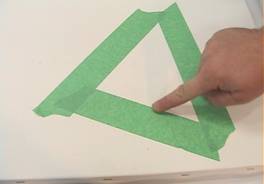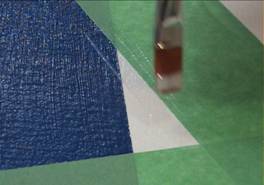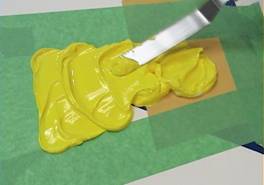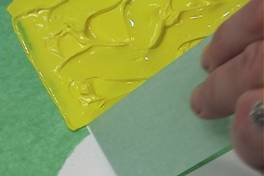Hard Edge Techniques
HARD EDGE TECHNIQUES USING GOLDEN PRODUCTS
This Application Sheet discusses how to reduce the common issues artists experience when employing hard edge techniques in their artwork. The methods and products will vary dependant on the surface, paint consistency and surface texture, so the various processes are broken down into three sections.
It"s important to note that hard edge painting requires a good deal of applying tape and then using pressure to burnish edges, and subsequently pulling tape off. All of which may sag the canvas and are more difficult to attempt on stretched canvases, so when doing a painting with a lot of hard edge techniques, it's generally better to work on rigid supports or at least temporarily secure the canvas to a panel.
THIN PAINT FILMS
Base Color Technique
This first method is most useful for thinner paint layers and where the underlying layer of paint is one uniform base paint color. The base color is applied and allowed to dry.




- The desired area is masked off with painter's tape. Various kinds of tapes may be used, but overall the kinds of low-adhesive masking tapes used for house painting are an excellent choice. Standard masking tapes and other kinds of tapes can be used, but testing is highly suggested to assure they don"t pull up the underlying paint, or leave an unwanted residue behind.
- Once the tape is applied, burnish the inside edge with a finger (Image 1).
- Next, the same base paint color is applied again, and allowed to dry (Image 2). The purpose of this application is to seal the inside edge, which later helps in preventing the intended paint color from seeping and creeping underneath the tape edge. This is especially important when working on surfaces with any degree of texture.
- Finally, the desired paint layer is applied. Fresh acrylic paint films tend to be very elastic and can stretch when the tape is removed. To help reduce this, GOLDEN GAC 200 can be blended with the paint. This hard acrylic binder helps to create a cleaner edge. Adding GAC 200 decreases the pigment level of the paint, so if opacity is critical, keep the GAC 200 additions to a minimum amount, such as 2:1 (paint to GAC 200). Products with a high solids content - such as GOLDEN Gesso - work without having to add the GAC 200 because these solids-loaded materials are not as elastic as many paints, especially those with tiny pigment particles.
- Apply thin and even, and apply as many coats as needed to achieve the desired opacity.
- Once the final paint layer is allowed to dry, then the masking is pulled off (Image 3). Pull the tape off at a sharp angle, as this helps facilitate a cleaner edge.
Acrylic Medium Edge Sealing Technique
- The Base Color Technique works well with one solid underlying color, but as the painting develops and there are multiple colors to work over, It becomes more complex to seal the inside tape edge. A clear medium can effectively seal the edge, and because it"s clear, any seepage won"t be too obvious, especially if the artwork is eventually varnished.
- The preferred clear medium for hard edge tape sealing is a blend of GAC 200 and GAC 500 at a 3:1 ratio. This mix of a hard and regular acrylic medium is less elastic at room temperatures than other mediums, resulting in a crisper paint edge. Pay special attention to any areas where there might be gaps in the tape because of overlapping paint films (Image 4).
- Allow this layer to dry and repeat this process with additional medium coats until the entire tape edge is properly sealed. In hard edge painting, it"s always much easier to apply an extra sealing coat than having to clean up a ragged edge later.
- After the last layer of medium has dried, apply the paints – ideally also blended with GAC 200 – to the taped section.
THICK PAINT FILMS
This last technique is perhaps the simplest because the physical thickness of the paint layer inherently helps reduce seepage underneath the taped edge, as long as it's applied with some care.


- Start just like the previous methods, by taping the desired shape. Using paint or medium to seal the inside edge can be done, but it is often not necessary except on the most textural of surfaces. At a certain point one needs to understand such textural surfaces are going to be painfully difficult to mask and achieve hard edges. Nevertheless, this technique stands the best chance for success on more irregular surfaces.
- The paint films can be applied quite thickly, so the artist can extend the paints with a thick medium, such as High Solid Gel Gloss. This increases the consistency to aid in achieving a hard edge, and also extends the paints to reduce overall cost. Opacity is less of a concern in thickly applied paint layers, so generous amounts of gel can be added into the paint.
- The paint is then applied onto the desired masked area. Take care to not force the paint towards the inside edge, and also try to apply the paint gently because it can seep under the tape if one is not careful (Image 5). With practice, this application is quite simple. The wet product should completely cover the inside seam.
- As soon as the paint has been applied satisfactorily, remove the tape. When removing the tape, start with the last piece of tape applied, and pull it off as near vertical as possible because an angled edge will be quite visible in the dried film (Image 6).
- Allow the paint layer to fully dry (at least 24 hours or more) before proceeding.
A NOTE ON FORCE-DRYING ACRYLIC PAINTS
Hard edge painting means a lot of quickly applied paint and medium layers, and waiting for the coats to dry before moving onto the next layer. Therefore many artists will try to encourage a faster drying process. There are a couple of considerations to address to help avoid costly mistakes.
- Do not try to force-dry acrylic paint films too quickly, too soon. Hair driers are commonly employed in the acrylic paint studio, but try to start out with low temperature at low speeds and work farther away from the paint. If acrylic paints cure too fast, they can either craze or bubble, and even form very poor paint films that may not do too well over many decades. When in doubt, slow down.
- When using a hair drier to accelerate drying, keep in mind you are also heating up the tape and the substrate. Some tape adhesives become increasing tacky from high heat. Some substrates, such as acrylic sheeting, polycarbonate, PVC boards, etc. can deform when heated too high for too long of a period.
- Always allow the paint films to cool down before applying more tape or more paint. A warm acrylic paint film is very sticky, and tapes will adhere much more aggressively to the paint. Also paints applied over a hot surface tend to dry faster, making it more difficult to achieve even paint layers.
- When using heat to force-dry a painting, remember that moisture goes away from the heat source. If you heat from the top down, the moisture goes deeper into the paint and the substrate. Warming from the backside of the painting allows the moisture and other additives to escape from the paint layer.
Disclaimer
The above information is based on research and testing done by Golden Artist Colors, Inc., and is provided as a basis for understanding the potential uses of the products mentioned. Due to the numerous variables in methods, materials and conditions of producing art, Golden Artist Colors, Inc. cannot be sure the product will be right for you. Therefore, we urge product users to test each application to ensure all individual project requirements are met. While we believe the above information is accurate, WE MAKE NO EXPRESS OR IMPLIED WARRANTIES OF MERCHANTABILITY OR FITNESS FOR A PARTICULAR PURPOSE, and we shall in no event be liable for any damages (indirect, consequential, or otherwise) that may occur as a result of a product application.